History revisited in 2021 Annapolis Newport Race
Published on June 5th, 2021
One could be forgiven for thinking they had been transported back to the 1970s while watching the start of the 38th biennial Annapolis to Newport Race.
As the starting gun fired, Running Tide headed across the line on starboard tack followed by Kialoa III. Those two fabled sailboats did battle many times in major offshore distance races up and down the East Coast a half century ago.
The 2021 edition attracted 82 teams, with Running Tide and Kialoa III among the ORC 1 and 2 starters on June 5, while a day earlier saw starts get underway for ORC 3, ORC 4, ORC 5, ORC Doublehanded, and PHRF and PHRF Classic.
In the 1975 edition of the Annapolis-to-Newport Race, Kialoa III and Running Tide finished second and third, respectively, in Class I behind Salty Goose. Kialoa III, just launched that year for owner Jim Kilroy, set an elapsed time record of 55 hours and 40 minutes.
Running Tide, owned at the time by Al Van Metre, would end years of frustration by winning IOR Class I in the 1981 and ’83 editions of Annapolis-to-Newport.
Beau Van Metre bought back Running Tide 34 years after selling the legendary race-boat and spent $4.5 million restoring and updating her. The northern Virginia real estate developer hired respected designer David Pedrick to oversee the refit with the purpose of making the Sparkman & Stephens 61-footer competitive in 2021.
That goal was achieved by redistributing the weight from above the deck to below the floorboards. Running Tide was built in 1969 with all stainless-steel rigging and deck hardware. Van Metre installed a carbon-fiber mast that is 10 feet taller and one-third the weight of the original. Instead of 16 huge winches, Running Tide now only has six and they weigh a fraction of their predecessors.
A new carbon-fiber rudder is 200 pounds lighter than the one it replaced and provides far better maneuverability. “The boat feels like it has power steering now. It was like driving a dump truck before,” Van Metre said.
All those technological upgrades have clearly made a major difference as Running Tide paced well with the competition in its class during the first few miles of the 2021 Annapolis-to-Newport Race.
Kialoa III, on the other hand, showed its age and quickly fell way behind the pack during the upwind start on the Chesapeake Bay. Ironically, Pedrick designed that 79-foot ketch while working for Sparkman & Stephens back in 1974. The Palmer Johnson-built boat was converted to a sloop in 1976 and held the Sydney-to-Hobart Race record for 21 years.
Now owned by Thorpe Leeson of Newport, Rhode Island, Kialoa III does not appear to have been retrofitted or otherwise updated much from its glory days.
Van Metre had numerous professional sailors aboard as crew, including former America’s Cup competitors Larry Leonard and Mike Toppa as watch captains. Leonard was among several Annapolis natives who know the Chesapeake Bay like the back of their hands and advised Van Metre to take Running Tide to the Eastern Shore side of the bay.
Van Metre appeared a bit nervous at the wheel as he worked hard to point the old warhorse so she could cross in front of a tugboat pushing a barge that was bearing down on Running Tide as it sailed through the shipping channel.
After narrowly clearing the commercial vessel, Running Tide came as close to Kent Island as its 10-foot draft would allow before finally tacking onto port.
Another reason for crossing the shipping channel was to get into deep water as an ebb tide helped propel the fleet south toward Norfolk. Also, those boats on the Eastern Shore side of the bay were first to sail into the building sea breeze, which piped up to around eight knots as the leaders headed toward Bloody Point.
Despite the many updates, Running Tide is still a vastly outdated design as there have been five decades of technological improvements to racing sailboats. Van Metre has no idea how Running Tide 2.0 will perform versus its competition in ORC 2 class.
“We’re all anxious to see if the improvements we made will work. Nobody knows how it’s going to play out,” he said prior to the start. “I can tell you from sailing the boat that it feels much faster, a lot livelier. I know the rig and sails are a hundred times better. We’ll know in the first couple hours how well the boat is performing.”
For the second day of starts, organizers with Annapolis Yacht Club certainly did not want to postpone the start of a 475-nautical mile distance race, but it appeared for a while that might be necessary because there was not enough wind to propel the fleet across the line.
About an hour before the 11 am warning gun, the entire fleet sat becalmed with either no sails hoisted or just the main. Fortunately, about 15 minutes before the race committee went into sequence, the sea breeze started to fill in at around 4 to 6 knots and competitors were able to begin pre-start maneuvers.
“Things were looking ugly there for a while, but we got lucky and had enough wind to start on time,” principal race officer Dick Neville said.
Almost all of the 21 boats in two classes that started together were on starboard near the pin end of the line. Prospector, a Mills 68 that is largest boat in the fleet and favored to post the best elapsed time, quickly tacked onto port and sailed to the western shore.
That proved a mistake as the pressure was not nearly as strong on that side of the Chesapeake Bay and shallower water lessened the positive impact of the current. Prospector, owned by Shelter Island Transatlantic Partners, did not need long to overcome that temporary setback and move to the front of the Saturday starters.
By 5 pm while on approach to the Potomac River, Prospector had built a four-mile lead on the nearest boat — the Cookson 50 Privateer.
Prospector completed the 120-nautical mile Chesapeake Bay portion of the race in a phenomenal time of just under eight hours during the 2019 edition of Annapolis-to-Newport. The Newport-based boat was on pace to break the course record of 40 hours, 14 minutes and 36 seconds that was set by the Volvo 70 Warrior in 2017.
However, Prospector was dismasted while beating into 20-25 knot winds and eight-foot seas in the Atlantic Ocean, approximately 30 miles offshore and 70 miles north of Chesapeake Light.
“Our number one goal this time around is to finish the race,” said Larry Landry, one of four owners and navigator aboard Prospector. “We showed last time that we’re perfectly capable of having things go wrong.”
Forecasts call for the fleet to face upwind conditions for the entire passage through the Chesapeake Bay. Southwesterly winds will predominate in the Atlantic Ocean, providing running and reaching angles almost all the way to Newport.
Landry acknowledged the chances of breaking the course record this year are slim, but was hopeful the day two starters will get better breeze in the bay than the day before, allowing Prospector to post the fastest elapsed time.
“It all depends on the conditions we’re dealt in the Chesapeake Bay,” he said. “If we can get out of the bay early Sunday morning (June 6), we should be in pretty good shape.”
Chessie Racing, a Tripp 62 owned by Annapolis Yacht Club member George Collins, was the biggest and fastest of the 61 boats in six classes that started on June 4. “What am I doing on this boat? This is crazy, I’m too old for this stuff,” Collins said with a chuckle.
Collins was a regular participant in the Annapolis-to-Newport Race when he lived on Gibson Island and was CEO of T. Rowe Price. He fondly recalls the 1997 edition when his Mumm 36 Moxie finished third in Class V behind a pair of 70-footers — Trader and Donnybrook.
“We crossed the Chesapeake Bay Tunnel right behind Donnybrook and they were shocked,” he said.
Collins become a Chesapeake Bay folk hero when he personally bankrolled Chessie Racing, the Baltimore-Annapolis entry in the 1997-98 Whitbread Round the World Race. He spent $7 million of his own money to fund the campaign, which was instrumental in Baltimore and Annapolis getting a stopover in the famous race.
Long since retired and splitting time between homes in Fisher Island, Florida and Guilford, Connecticut, the 81-year-old Collins races his largest sailboat very rarely these days. However, he has a reliable crew led by captain Ian Gordon whenever he does take Chessie Racing offshore.
“My hopes are that we have fun and don’t break anything. We should be the first boat to finish, but you need to cross the line off Newport to do that,” Collins said. “I’ve done too many distance races when gear broke or something else went wrong to expect a certain result.”
The Naval Academy Varsity Offshore Sailing team has always used the Annapolis-to-Newport Race as the kickoff to its summer training. Coach Jahn Tihansky entered five boats with the Navy 44-footers Integrity and Defiance starting June 4. A pair of Farr 40-footers (Ranger and Zephyr) along with the J/133 Wasp started a day later.
“We’re a little thin on experience this time. Having lost last summer really hurt. Only the rising first class has been offshore before,” Tihansky said. “We’re definitely behind the eight-ball when it comes to blue water experience.”
Tihansky and other coaches will be aboard all five boats as safety officers, providing experienced guidance while allowing the midshipmen to make all key decisions and perform the crew work.
“Getting there safe is always the number one goal. Given the overall lack of experience, I think the expectation to win is not really applicable in this scenario,” Tihansky said.
UPDATE: Chessie Racing, a Tripp 62 owned by George Collins, was the biggest and fastest of the boats that started on June 4, and they wasted little time getting to Newport. They are the first (and only) finisher with an elapsed time of 2:06:27:37. – Full report
Event information – Race details – Tracking
Source: Bill Wagner


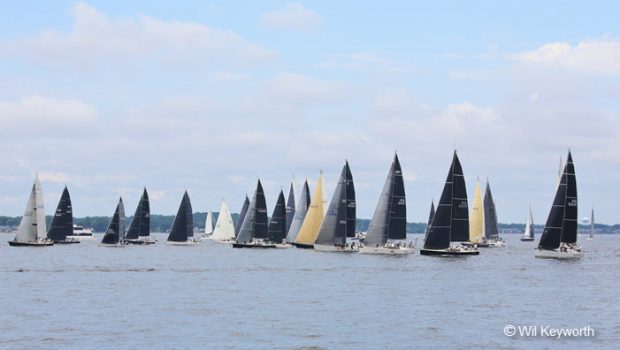


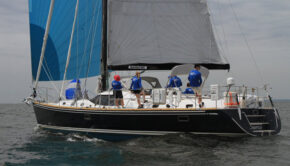
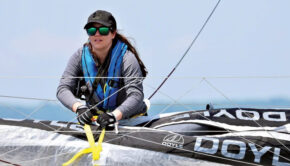
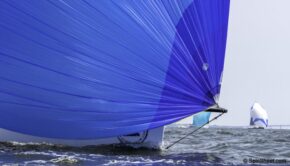
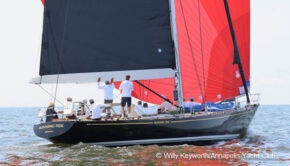
 We’ll keep your information safe.
We’ll keep your information safe.